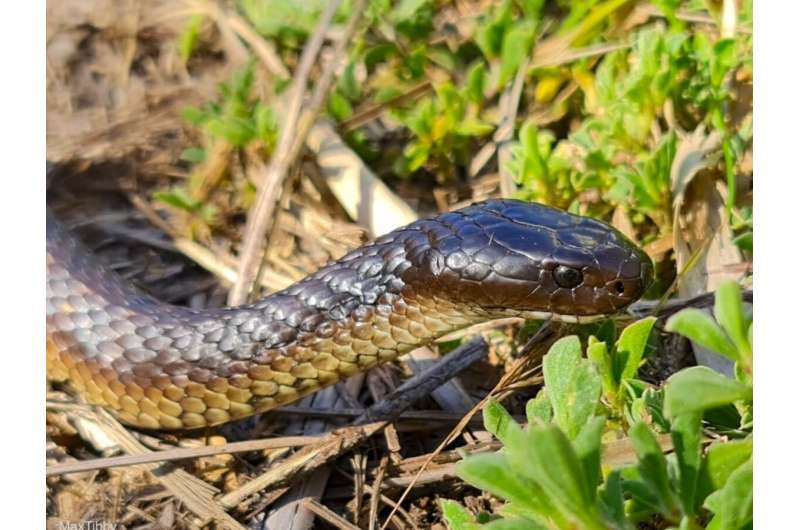This article has been reviewed according to Science X's editorial process and policies. Editors have highlighted the following attributes while ensuring the content's credibility:
fact-checked
peer-reviewed publication
trusted source
proofread
Island tiger snakes' skulls adapt to eat large sea bird chicks

A study by researchers from the University of Adelaide and other institutions has found that in a population of island tiger snakes, the bones in their jaws increase in length after feeding on large prey, while their mainland counterparts show no change.
The new study, published in Evolutionary Biology, presents the first detailed examination of the effects that diet has on the head shape of tiger snakes, a phenomenon known as diet-induced phenotypic plasticity.
"Much like an athlete's body changes shape with intense training, an island tiger snake's skull adapts to the food it needs to survive," said senior author Dr. Alessandro Palci from the School of Biological Sciences at the University of Adelaide.
"Island tiger snakes start showing shape changes in their skull bones only after prolonged feeding on large prey.
"Skulls of island tiger snakes are better able to change their growth when trained on different foods. The ability to change head shape during a lifetime as a result of diet increases these tiger snakes' ability to survive in environments such as islands where there is unusually large prey."
The researchers examined two populations of tiger snakes in Western Australia—mainland tiger snakes from Herdsman Lake, in the north-west Perth suburb of Herdsman, and tiger snakes from Carnac Island, an island nature reserve about 10km south-west of Fremantle.
"Carnac Island is home to hundreds of tiger snakes that need to feed off the large chicks of seabirds to survive," said lead author Ammresh, whose thesis on this topic was recently awarded first class Honors in Ecology and Evolutionary Biology at the University of Adelaide.
"It is fascinating to see them adapt in real time, changing their skull shape within their lifetime to allow them to consume prey three times the size of what is available on the mainland.
"What makes this study different from previous ones, is that we used computer tomography data and measurements on 3D digital models of the skull bones. These 3D digital models allow us to get an extremely accurate representation of the skull of the tiger snakes, which hasn't been available previously."
Dr. Palci added, "Not all evolutionary change takes millions of years, as it is often assumed by people when they think of Darwinian evolution. Tiger snakes were introduced on Carnac Island less than a century ago, but phenotypic plasticity combined with intense natural selection allowed them to adapt very quickly, so that visible changes appeared after only a few generations."
More information: Ammresh et al, Island Tiger Snakes (Notechis scutatus) Gain a 'Head Start' in Life: How Both Phenotypic Plasticity and Evolution Underlie Skull Shape Differences, Evolutionary Biology (2023). DOI: 10.1007/s11692-022-09591-z
Journal information: Evolutionary Biology
Provided by University of Adelaide




















